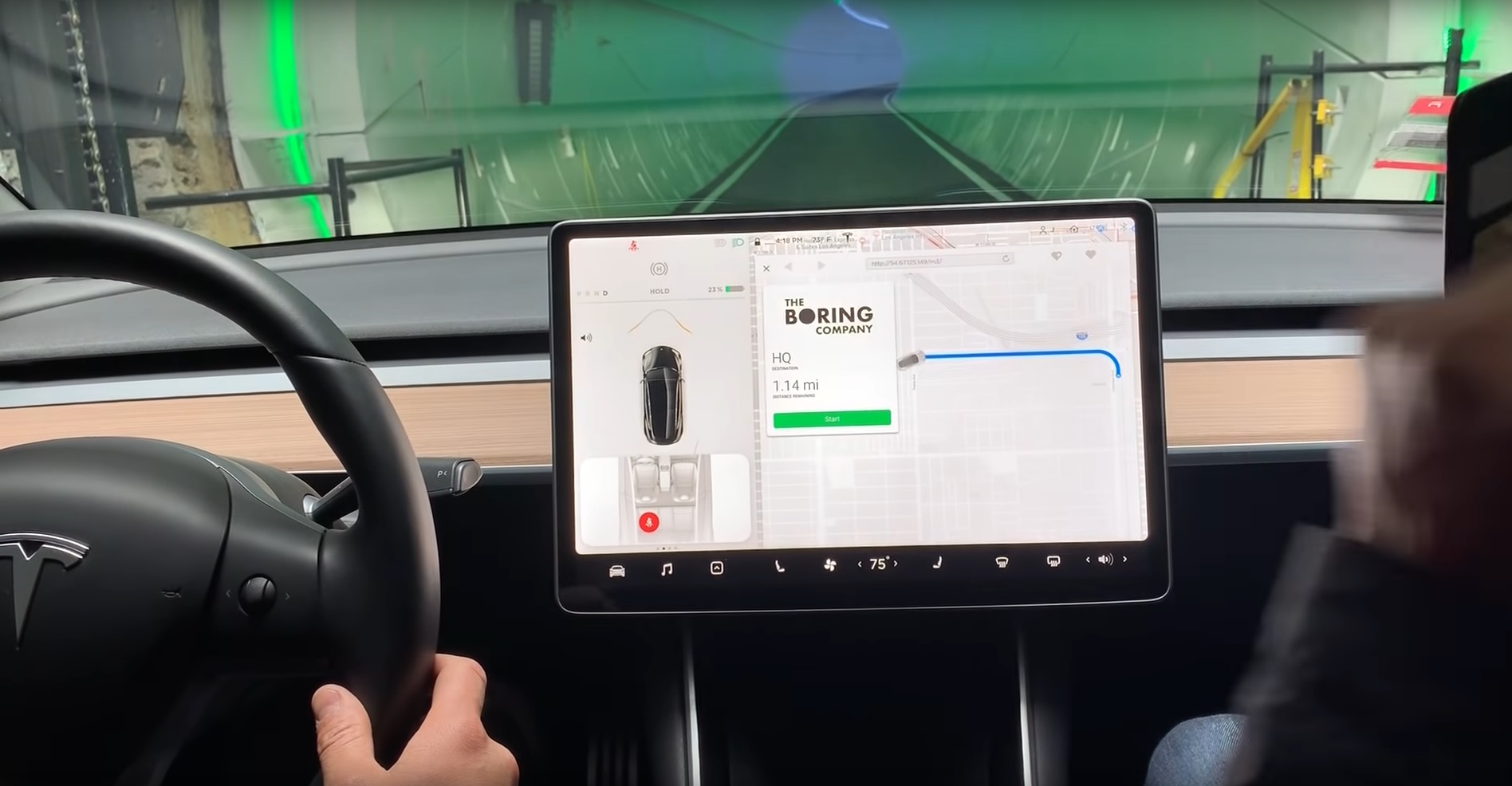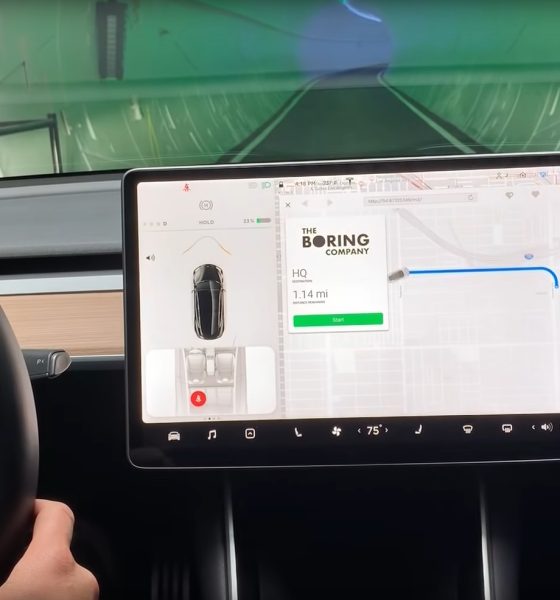

News
Tesla Model 3 zips through Boring Co. tunnel at 116 mph in latest video
The Boring Company has been busy refining its tunnel technology since unveiling it last December, and a new video shared by venture capitalist and Tesla board member Steve Jurvetson has provided the best encapsulation of the experience yet.
In the video, a Boring Company team member is first seen transporting Jurvetson and another passenger in a Tesla Model 3 onto the system’s elevator entrance while discussing driver options during the journey. “We usually offer a slower ride on Autopilot or a fast ride [with] manual driving,” the driver explained. The group then sped through the tunnel, reaching a maximum 116 mph while crossing the underground distance from the corner of Prairie & 120th Street to the corner of Crenshaw & Rocket Rd in Hawthorne, CA. Total travel time between each of the the tunnel ends was about one minute.
The Model 3 driver also revealed upcoming self-driving options for future Boring tunnel transits. “Right now Autopilot goes up to 90 [mph], and we’re increasing it to 125,” he detailed. The group traveled using the manual driving option in the video, however. Alongside updates to driving options available, a button labeled “Request Departure” was added to initiate the tunnel journey via the all-electric midsize sedan’s touchscreen, and route information was displayed while underground.
Note: The original video referenced was removed from YouTube shortly after this article was published. Another version was uploaded to Twitter and is posted below.
https://twitter.com/tesla_truth/status/1142235000554676224?s=21
As seen in the last Boring update posted in May, the Model 3 in the travel demo was not using the vehicle skates present during the company’s opening party. The traffic-busting tunnel now appears to have a much smoother ride thanks to this change, something Boring Company founder Elon Musk previously explained as, “simple and just works.” This change and other subtle additions and modifications demonstrate both Musk’s and the company’s desire to continuously innovate their technology.
The Boring Company was created as a two-fold answer to frustrating traffic situations. First, it’s an alternative travel route that avoids above-ground congestion; and second, it lowers the cost of tunnel boring technology overall by using new design and engineering approaches to old digging machines. The venture’s one-mile demo tunnel was built for about $10 million dollars as compared to the $500-$1 billion dollars it traditionally costs to dig a tunnel of the same length. Notably, Jurvetson simultaneously shared a few photos of the tunnel boring machine being used for the company’s current projects with his video.
Bypassing the LA Rush Hour Commute, at 116 MPH, underground.
I took video: https://t.co/ZZmO160INlThe latest iteration on the @BoringCompany masterplan to resolve soul deadening traffic. Did you know that a tunnel is just about the best terrestrial place to be in an earthquake? pic.twitter.com/foNznpdCG9
— Steve Jurvetson (@FutureJurvetson) June 22, 2019

The short Hawthorne-based test tunnel isn’t the only transit project Musk’s underground venture has on its manifest. Last month, board members of the Las Vegas Convention and Visitors Authority approved a Boring Company contract to build two tunnels to transport passengers between locations under their convention center. Additionally, an environmental assessment was recently completed for a Boring-built tunnel between Washington DC and Baltimore, Maryland that will enable 15-minute trips between the two destinations. If approved, Hyperloop technology may also be compatible with the system, introducing travel speeds of over 600 mph.
Overall, The Boring Company continues its growth into yet another industry disruption that challenges the status quo. Smoother rides are definitely a step in the right direction, and Autopilot integration seems like a natural fit considering Tesla’s push towards autonomy and long-term vision.

Elon Musk
Starlink passes 9 million active customers just weeks after hitting 8 million
The milestone highlights the accelerating growth of Starlink, which has now been adding over 20,000 new users per day.

SpaceX’s Starlink satellite internet service has continued its rapid global expansion, surpassing 9 million active customers just weeks after crossing the 8 million mark.
The milestone highlights the accelerating growth of Starlink, which has now been adding over 20,000 new users per day.
9 million customers
In a post on X, SpaceX stated that Starlink now serves over 9 million active users across 155 countries, territories, and markets. The company reached 8 million customers in early November, meaning it added roughly 1 million subscribers in under seven weeks, or about 21,275 new users on average per day.
“Starlink is connecting more than 9M active customers with high-speed internet across 155 countries, territories, and many other markets,” Starlink wrote in a post on its official X account. SpaceX President Gwynne Shotwell also celebrated the milestone on X. “A huge thank you to all of our customers and congrats to the Starlink team for such an incredible product,” she wrote.
That growth rate reflects both rising demand for broadband in underserved regions and Starlink’s expanding satellite constellation, which now includes more than 9,000 low-Earth-orbit satellites designed to deliver high-speed, low-latency internet worldwide.
Starlink’s momentum
Starlink’s momentum has been building up. SpaceX reported 4.6 million Starlink customers in December 2024, followed by 7 million by August 2025, and 8 million customers in November. Independent data also suggests Starlink usage is rising sharply, with Cloudflare reporting that global web traffic from Starlink users more than doubled in 2025, as noted in an Insider report.
Starlink’s momentum is increasingly tied to SpaceX’s broader financial outlook. Elon Musk has said the satellite network is “by far” the company’s largest revenue driver, and reports suggest SpaceX may be positioning itself for an initial public offering as soon as next year, with valuations estimated as high as $1.5 trillion. Musk has also suggested in the past that Starlink could have its own IPO in the future.
News
NVIDIA Director of Robotics: Tesla FSD v14 is the first AI to pass the “Physical Turing Test”
After testing FSD v14, Fan stated that his experience with FSD felt magical at first, but it soon started to feel like a routine.

NVIDIA Director of Robotics Jim Fan has praised Tesla’s Full Self-Driving (Supervised) v14 as the first AI to pass what he described as a “Physical Turing Test.”
After testing FSD v14, Fan stated that his experience with FSD felt magical at first, but it soon started to feel like a routine. And just like smartphones today, removing it now would “actively hurt.”
Jim Fan’s hands-on FSD v14 impressions
Fan, a leading researcher in embodied AI who is currently solving Physical AI at NVIDIA and spearheading the company’s Project GR00T initiative, noted that he actually was late to the Tesla game. He was, however, one of the first to try out FSD v14.
“I was very late to own a Tesla but among the earliest to try out FSD v14. It’s perhaps the first time I experience an AI that passes the Physical Turing Test: after a long day at work, you press a button, lay back, and couldn’t tell if a neural net or a human drove you home,” Fan wrote in a post on X.
Fan added: “Despite knowing exactly how robot learning works, I still find it magical watching the steering wheel turn by itself. First it feels surreal, next it becomes routine. Then, like the smartphone, taking it away actively hurts. This is how humanity gets rewired and glued to god-like technologies.”
The Physical Turing Test
The original Turing Test was conceived by Alan Turing in 1950, and it was aimed at determining if a machine could exhibit behavior that is equivalent to or indistinguishable from a human. By focusing on text-based conversations, the original Turing Test set a high bar for natural language processing and machine learning.
This test has been passed by today’s large language models. However, the capability to converse in a humanlike manner is a completely different challenge from performing real-world problem-solving or physical interactions. Thus, Fan introduced the Physical Turing Test, which challenges AI systems to demonstrate intelligence through physical actions.
Based on Fan’s comments, Tesla has demonstrated these intelligent physical actions with FSD v14. Elon Musk agreed with the NVIDIA executive, stating in a post on X that with FSD v14, “you can sense the sentience maturing.” Musk also praised Tesla AI, calling it the best “real-world AI” today.
News
Tesla AI team burns the Christmas midnight oil by releasing FSD v14.2.2.1
The update was released just a day after FSD v14.2.2 started rolling out to customers.

Tesla is burning the midnight oil this Christmas, with the Tesla AI team quietly rolling out Full Self-Driving (Supervised) v14.2.2.1 just a day after FSD v14.2.2 started rolling out to customers.
Tesla owner shares insights on FSD v14.2.2.1
Longtime Tesla owner and FSD tester @BLKMDL3 shared some insights following several drives with FSD v14.2.2.1 in rainy Los Angeles conditions with standing water and faded lane lines. He reported zero steering hesitation or stutter, confident lane changes, and maneuvers executed with precision that evoked the performance of Tesla’s driverless Robotaxis in Austin.
Parking performance impressed, with most spots nailed perfectly, including tight, sharp turns, in single attempts without shaky steering. One minor offset happened only due to another vehicle that was parked over the line, which FSD accommodated by a few extra inches. In rain that typically erases road markings, FSD visualized lanes and turn lines better than humans, positioning itself flawlessly when entering new streets as well.
“Took it up a dark, wet, and twisty canyon road up and down the hill tonight and it went very well as to be expected. Stayed centered in the lane, kept speed well and gives a confidence inspiring steering feel where it handles these curvy roads better than the majority of human drivers,” the Tesla owner wrote in a post on X.
Tesla’s FSD v14.2.2 update
Just a day before FSD v14.2.2.1’s release, Tesla rolled out FSD v14.2.2, which was focused on smoother real-world performance, better obstacle awareness, and precise end-of-trip routing. According to the update’s release notes, FSD v14.2.2 upgrades the vision encoder neural network with higher resolution features, enhancing detection of emergency vehicles, road obstacles, and human gestures.
New Arrival Options also allowed users to select preferred drop-off styles, such as Parking Lot, Street, Driveway, Parking Garage, or Curbside, with the navigation pin automatically adjusting to the ideal spot. Other refinements include pulling over for emergency vehicles, real-time vision-based detours for blocked roads, improved gate and debris handling, and Speed Profiles for customized driving styles.








